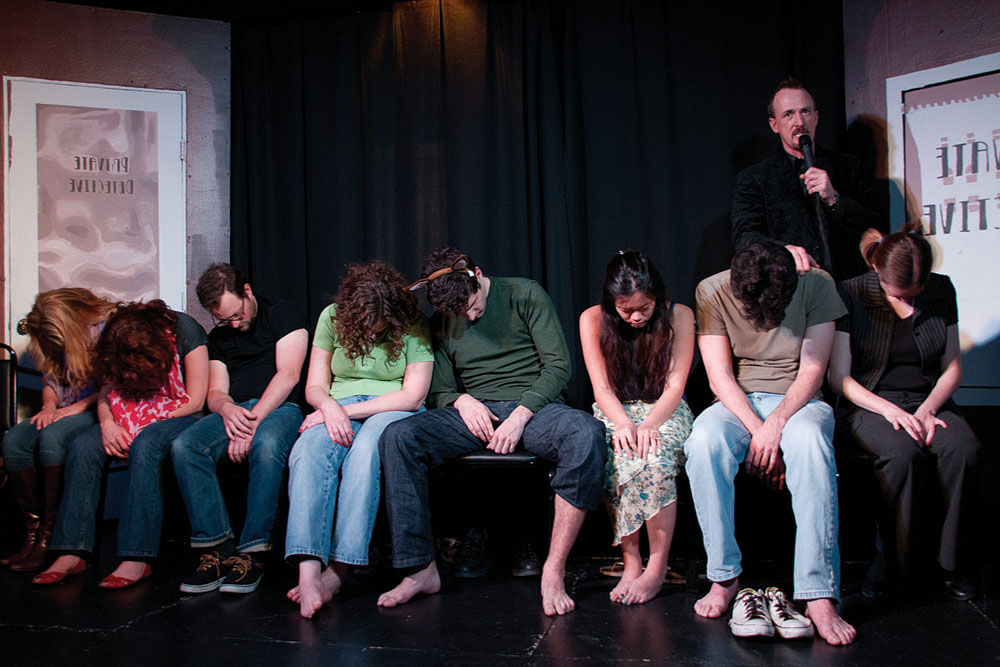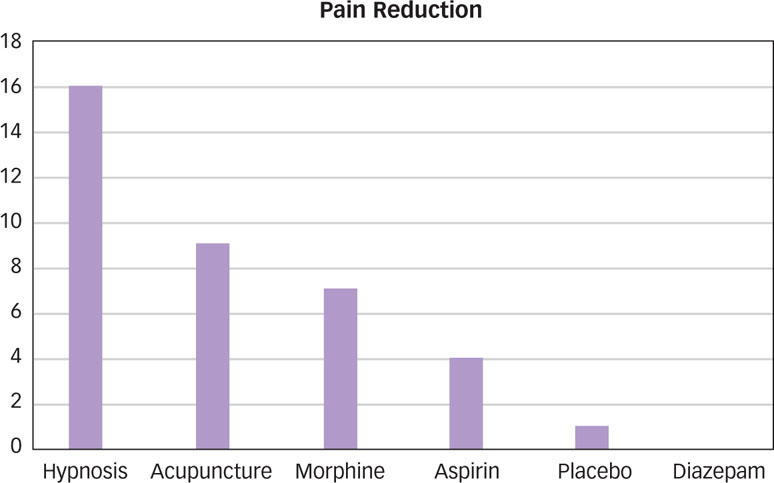5.4 Hypnosis: Open to Suggestion
You may have never been hypnotized, but you have probably heard or read about it. Its wonders are often described with an air of amazement, and demonstrations of stage hypnosis make it seem very powerful and mysterious. When you think of hypnosis, you may envision people completely under the power of a hypnotist, who is ordering them to dance like a chicken or perhaps “regress” to early childhood and talk in childlike voices. Many common beliefs about hypnosis are false. Hypnosis refers to a social interaction in which one person (the hypnotist) makes suggestions that lead to a change in another person’s (the subject’s) subjective experience of the world (Kirsch et al., 2011). The essence of hypnosis is in leading people to expect that certain things will happen to them that are outside their conscious will (Wegner, 2002).
Induction and Susceptibility
To induce hypnosis, a hypnotist may ask the person to be hypnotized to sit quietly and focus on some item, such as a spot on the wall (or a swinging pocket watch), and then make suggestions to the person about what effects hypnosis will have (e.g., “your eyelids are slowly closing” or “your arms are getting heavy”). Even without hypnosis, some suggested behaviors might commonly happen just because a person is concentrating on them—
What makes someone easy to hypnotize?
Not everyone is equally hypnotizable. Susceptibility varies greatly. Some highly suggestible people are very easily hypnotized, most people are only moderately influenced, and some people are entirely unaffected by attempts at hypnosis. Susceptibility is not easily predicted by a person’s personality traits. A hypnotist will typically test someone’s hypnotic susceptibility with a series of suggestions designed to put a person into a more easily influenced state of mind. One of the best indicators of a person’s susceptibility is the person’s own judgment. So, if you think you might be hypnotizable, you may well be (Hilgard, 1965). People with active, vivid imaginations, or who are easily absorbed in activities such as watching a movie, are also somewhat more prone to be good candidates for hypnosis (Sheehan, 1979; Tellegen & Atkinson, 1974).
Hypnotic Effects
From watching stage hypnotism, you might think that the major effect of hypnosis is making people do peculiar things. So what do we actually know to be true about hypnosis? There are some impressive demonstrations that suggest real changes occur in those under hypnosis. At the 1849 festivities for Prince Albert of England’s birthday, for example, a hypnotized guest was asked to ignore any loud noises and then didn’t even flinch when a pistol was fired near his face. These days, hypnotists are discouraged from using firearms during stage shows, but they often have volunteers perform other impressive feats. One common claim for superhuman strength under hypnosis involves asking a hypnotized person to become “stiff as a board” and lie unsupported with shoulders on one chair and feet on another while the hypnotist stands on the hypnotized person’s body.
Studies have demonstrated that hypnosis can undermine memory, but with important limitations. People susceptible to hypnosis can be led to experience posthypnotic amnesia, the failure to retrieve memories following hypnotic suggestions to forget. Ernest Hilgard (1986) taught a hypnotized person the populations of some remote cities, for example, and then suggested that the participant forget the study session; the person was quite surprised after the session at being able to give the census figures correctly. Asked how he knew the answers, the individual decided he might have learned them from a TV program. Such amnesia can then be reversed in subsequent hypnosis.
215

HYPNOTIST: ERIC WALDEN (HTTPS:/
Importantly, research has found that only memories that were lost under hypnosis can be retrieved through hypnosis. The false claim that hypnosis helps people to unearth memories that they are not able to retrieve in normal consciousness seems to have surfaced because hypnotized people often make up memories to satisfy the hypnotist’s suggestions. For example, Paul Ingram, a sheriff’s deputy accused of sexual abuse by his daughters in the 1980s, was asked by interrogators in session after session to relax and imagine having committed the crimes. He emerged from these sessions having confessed to dozens of horrendous acts of “satanic ritual abuse.” These confessions were called into question, however, when independent investigator Richard Ofshe used the same technique to ask Ingram about a crime that Ofshe had simply made up out of thin air, something of which Ingram had never been accused. Ingram produced a three-
Hypnosis can lead to measurable physical and behavioral changes in the body. One well-

 Figure 5.13: Hypnotic analgesia The degree of pain reduction reported by people using different techniques for the treatment of laboratory-
Figure 5.13: Hypnotic analgesia The degree of pain reduction reported by people using different techniques for the treatment of laboratory-What evidence supports the idea that hypnosis leads to observable changes in the body?
216
Hypnosis also has been shown to enable people to control mental processes previously believed to be beyond conscious control. For instance, the Stroop task (Stroop, 1935) is a classic psychological test in which a person is asked to name the color of words on a page (appearing in ink that is red, blue, green, etc.). This is a simple task. However, sometimes the words themselves are the names of colors, but are printed in a different color of the ink. It turns out that people are significantly slower, and make more errors, when naming ink colors that don’t match the content of the word (e.g., when the word “green” is written in red ink) than if the content is neutral or congruent (e.g., if the word “desk” or “red” is written in red ink). This effect is present no matter how hard we try. Amazingly, the effect is completely eliminated when highly suggestible people are hypnotized and told to respond to all words the same way (Raz et al., 2002). Importantly, though, follow-
Nevertheless, people under hypnotic suggestion are not merely telling the hypnotist what they want to hear. Instead, they seem to be experiencing what they have been asked to experience. Under hypnotic suggestion, for example, regions of the brain responsible for color vision are activated in highly hypnotizable people when they are asked to perceive color, even when they are really shown gray stimuli (Kosslyn et al., 2000). While engaged in the Stroop task, people who can eliminate the Stroop effect under suggestion show decreased activity in the anterior cingulate cortex (ACC), the part of the brain involved in conflict monitoring (FIGURE 5.14; Raz, Fan, & Posner 2005), consistent with the lack of conflict perceived between the color name and ink. Overall, hypnotic suggestion appears to change the subjective perception of those experiencing it, as reflected by changes in their self-

 Figure 5.14: Brain Activity during Hypnosis (a) Researchers found that the anterior cingulate cortex is activated in all people during the Stroop task. The anterior cingulate cortex (shown in the cross-
Figure 5.14: Brain Activity during Hypnosis (a) Researchers found that the anterior cingulate cortex is activated in all people during the Stroop task. The anterior cingulate cortex (shown in the cross-217
 Hypnosis is an altered state of consciousness characterized by suggestibility.
Hypnosis is an altered state of consciousness characterized by suggestibility. Although many claims for hypnosis overstate its effects, hypnosis can create the experience that one’s actions are occurring involuntarily, create analgesia, and even change brain activations in ways that suggest that hypnotic experiences are more than imagination.
Although many claims for hypnosis overstate its effects, hypnosis can create the experience that one’s actions are occurring involuntarily, create analgesia, and even change brain activations in ways that suggest that hypnotic experiences are more than imagination.
OTHER VOICES: A Judge’s Plea for Pot

Should all drugs be illegal? Where should we draw the line between acceptable chemical alteration of one’s own consciousness and criminal or pathological behavior? Let’s take a specific example—
Three and a half years ago, on my 62nd birthday, doctors discovered a mass on my pancreas. It turned out to be Stage 3 pancreatic cancer. I was told I would be dead in four to six months. Today I am in that rare coterie of people who have survived this long with the disease. But I did not foresee that after having dedicated myself for 40 years to a life of the law, including more than two decades as a New York State judge, my quest for ameliorative and palliative care would lead me to marijuana.
My survival has demanded an enormous price, including months of chemotherapy, radiation hell and brutal surgery. For about a year, my cancer disappeared, only to return. About a month ago, I started a new and even more debilitating course of treatment. Every other week, after receiving an IV booster of chemotherapy drugs that takes three hours, I wear a pump that slowly injects more of the drugs over the next 48 hours.
Nausea and pain are constant companions. One struggles to eat enough to stave off the dramatic weight loss that is part of this disease. Eating, one of the great pleasures of life, has now become a daily battle, with each forkful a small victory. Every drug prescribed to treat one problem leads to one or two more drugs to offset its side effects. Pain medication leads to loss of appetite and constipation. Anti-
Inhaled marijuana is the only medicine that gives me some relief from nausea, stimulates my appetite, and makes it easier to fall asleep. The oral synthetic substitute, Marinol, prescribed by my doctors, was useless. Rather than watch the agony of my suffering, friends have chosen, at some personal risk, to provide the substance. I find a few puffs of marijuana before dinner gives me ammunition in the battle to eat. A few more puffs at bedtime permits desperately needed sleep.
This is not a law-
Cancer is a nonpartisan disease, so ubiquitous that it’s impossible to imagine that there are legislators whose families have not also been touched by this scourge. It is to help all who have been affected by cancer, and those who will come after, that I now speak. Given my position as a sitting judge still hearing cases, well-
Because criminalizing an effective medical technique affects the fair administration of justice, I feel obliged to speak out as both a judge and a cancer patient suffering with a fatal disease…. Medical science has not yet found a cure, but it is barbaric to deny us access to one substance that has proved to ameliorate our suffering.
How should we decide which consciousness-
Copyright © 1997 Alfred A. Knopf, Inc.
218